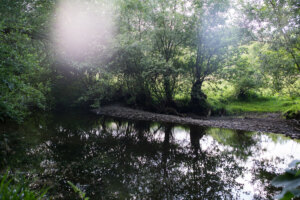
Materialities of Spatial Confinement: Trefeglwys meets Beirut
The farmer moved the sheep to the next field up the hill, they have eaten all the grass in the field across the lane since we came here at the beginning of the lockdown. That’s how long we have been here.
We only eat chicken now. Meat is so expensive that most people stopped buying it. Soon the whole country will become vegetarian like you.
It was the first time I saw farm dogs herding sheep. It was amazing, they are pretty good at it, and guess what, I saw a hare; a real hare, with long ears and all.
The dollar is trading at 14,000LL on the black market today. Imagine? The Lebanese pound lost about 90% of its value since you were last here in 2019.
A flycatcher bird nested on the house wall. I always wondered if birds left their nests unattended. We set up a nature camera so we can see the chicks getting fed.
Live rounds were fired last night on old demarcation lines between Chiah and Ain el-Remmaneh. Did you watch the news?
There are estimates of over 140,000 COVID-19 deaths in the UK, and only about 8,500 in Lebanon. It is amazing that despite everything, Lebanon has better handled the global pandemic than the UK.
Has it, though?
I spent the first UK lockdown in a beautiful Welsh village called Trefeglwys – it took me around ten weeks to learn to spell its name. It was like living in a postcard, with breathtaking open wide fields, a river, woods, and green hills all around. This was the material reality of my spatial (non)confinement. We got there just in time for lambing season too, so there were lambs jumping around, like in dreamland visions. We lived in a 380-year-old Grade-2 listed Tudor house, which is now part of my British family heritage.

Photo credit – Dan Burwood
Meanwhile, Lebanon has been going through the worst economic crisis in its modern history, one of the three most severe the world has seen since the mid-19th century, according to a 2021 report by the World Bank.
In Beirut, my parents are buying candles because of power cuts. ‘It’s more romantic’, they jokingly say. ‘It’s like when you used to do your homework on candlelight, remember?’ I do remember, I think. ‘The only difference between growing up in the civil war, and now is that there are no bombs and fighting’, I tell them, partly to comfort myself that despite the darkness, they are safe. ‘Yes, most of the time’, they say.
These conversations got me thinking about the ways we will remember these lockdown years; what traces will remain in our everyday lives? What will my three-year old daughter remember, if anything at all?
I’ve recently started rereading Pierre Nora’s Realms of Memory for an article I’m writing on the mnemonic potential of crowd-sourced footage from Syria. With in mind the shortcomings of his account of archival memory, and his rather elitist conception of history making processes, I quite like Nora’s description of memory; I find it resonates well with how I, and my two space-bound families are likely to remember the past two years: ‘Memory being a phenomenon of emotion and magic, he writes, accommodates only those facts that suit it. It thrives on vague, telescoping reminiscences, on hazy general impressions or specific symbolic details. It is vulnerable to transferences, screen memories, censorings and projections of all kinds.’ (Nora, 1996: 3)
Despite the open fields and the wide outdoor spaces, ‘secluded’ is the one word that comes to my mind when I think of the first lockdown in Trefeglwys. Secluded, and digital, mostly because it involved a lot of screens, and behind those screens a part of my family which has been living through a social, political, and economic meltdown, haunted by the ghosts of civil war, and an under-reported COVID-19 pandemic.
Screens, voice notes and short video snaps. That is the symbolic material reality of our 2020 confinement story, so my daughter could remember what our family in Beirut looks like, when being with loved ones is a part of who we are, or what we do, again.
For now, she thinks all those people live in my phone.
An earlier version of this appears in the NEW THINKING #3.7 pamphlet.
